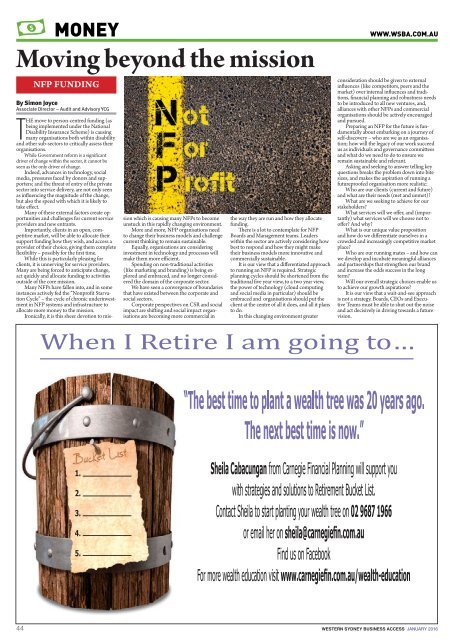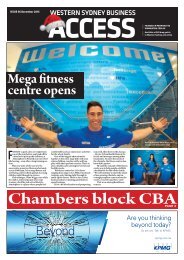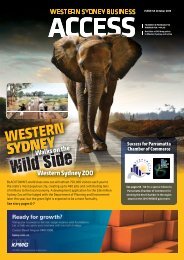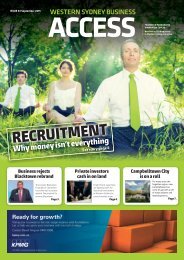ANITA COBBY
WSBA January 2016 Edition
WSBA January 2016 Edition
You also want an ePaper? Increase the reach of your titles
YUMPU automatically turns print PDFs into web optimized ePapers that Google loves.
MONEY<br />
WWW.WSBA.COM.AU<br />
Moving beyond the mission<br />
NFP FUNDING<br />
By Simon Joyce<br />
Associate Director – Audit and Advisory YCG<br />
THE move to person-centred funding (as<br />
being implemented under the National<br />
Disability Insurance Scheme) is causing<br />
many organisations both within disability<br />
and other sub-sectors to critically assess their<br />
organisations.<br />
While Government reform is a significant<br />
driver of change within the sector, it cannot be<br />
seen as the only driver of change.<br />
Indeed, advances in technology, social<br />
media, pressures faced by donors and supporters;<br />
and the threat of entry of the private<br />
sector into service delivery, are not only seen<br />
as influencing the magnitude of the change,<br />
but also the speed with which it is likely to<br />
take effect.<br />
Many of these external factors create opportunities<br />
and challenges for current service<br />
providers and new entrants.<br />
Importantly, clients in an open, competitive<br />
market, will be able to allocate their<br />
support funding how they wish, and access a<br />
provider of their choice, giving them complete<br />
flexibility – possibly for the first time.<br />
While this is particularly pleasing for<br />
clients, it is unnerving for service providers.<br />
Many are being forced to anticipate change,<br />
act quickly and allocate funding to activities<br />
outside of the core mission.<br />
Many NFPs have fallen into, and in some<br />
instances actively fed the “Nonprofit Starvation<br />
Cycle” – the cycle of chronic underinvestment<br />
in NFP systems and infrastructure to<br />
allocate more money to the mission.<br />
Ironically, it is this sheer devotion to mission<br />
which is causing many NFPs to become<br />
unstuck in this rapidly changing environment.<br />
More and more, NFP organisations need<br />
to change their business models and challenge<br />
current thinking to remain sustainable.<br />
Equally, organisations are considering<br />
investment in technology and processes will<br />
make them more efficient.<br />
Spending on non-traditional activities<br />
(like marketing and branding) is being explored<br />
and embraced, and no longer considered<br />
the domain of the corporate sector.<br />
We have seen a convergence of boundaries<br />
that have existed between the corporate and<br />
social sectors.<br />
Corporate perspectives on CSR and social<br />
impact are shifting and social impact organisations<br />
are becoming more commercial in<br />
the way they are run and how they allocate<br />
funding.<br />
There is a lot to contemplate for NFP<br />
Boards and Management teams. Leaders<br />
within the sector are actively considering how<br />
best to respond and how they might make<br />
their business models more innovative and<br />
commercially sustainable.<br />
It is our view that a differentiated approach<br />
to running an NFP is required. Strategic<br />
planning cycles should be shortened from the<br />
traditional five year view, to a two year view,<br />
the power of technology (cloud computing<br />
and social media in particular) should be<br />
embraced and organisations should put the<br />
client at the centre of all it does, and all it plans<br />
to do.<br />
In this changing environment greater<br />
consideration should be given to external<br />
influences (like competitors, peers and the<br />
market) over internal influences and traditions,<br />
financial planning and robustness needs<br />
to be introduced to all new ventures, and,<br />
alliances with other NFPs and commercial<br />
organisations should be actively encouraged<br />
and pursued.<br />
Preparing an NFP for the future is fundamentally<br />
about embarking on a journey of<br />
self-discovery – who are we as an organisation;<br />
how will the legacy of our work succeed<br />
us as individuals and governance committees<br />
and what do we need to do to ensure we<br />
remain sustainable and relevant.<br />
Asking and seeking to answer telling key<br />
questions breaks th e problem down into bite<br />
sizes, and makes the aspiration of running a<br />
futureproofed organisation more realistic:<br />
Who are our clients (current and future)<br />
and what are their needs (met and unmet)?<br />
What are we seeking to achieve for our<br />
stakeholders?<br />
What services will we offer, and (importantly)<br />
what services will we choose not to<br />
offer? And why?<br />
What is our unique value proposition<br />
and how do we differentiate ourselves in a<br />
crowded and increasingly competitive market<br />
place?<br />
Who are our running mates – and how can<br />
we develop and incubate meaningful alliances<br />
and partnerships that strengthen our brand<br />
and increase the odds success in the long<br />
term?<br />
Will our overall strategic choices enable us<br />
to achieve our growth aspirations?<br />
It is our view that a wait-and-see approach<br />
is not a strategy. Boards, CEOs and Executive<br />
Teams must be able to shut out the noise<br />
and act decisively in driving towards a future<br />
vision.<br />
44 WESTERN SYDNEY BUSINESS ACCESS JANUARY 2016






